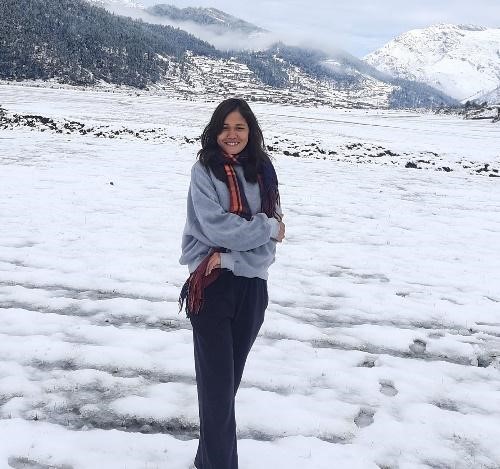

WCN provides two types of Grants
Both research grants financially support the academic and scientific research of young scientists from Nepal to expand knowledge of the nature conservation in Nepal. The Grants are provided to strengthen the research capacity of young researchers to enhance their skills, knowledge, and experience through their own research work. Grants are announced through WCN website with all the details on Grant amount, eligibility, obligations, deadline and application forms.
Bird Assemblages Along the Urbanization Gradient in Birendranagar City, Karnali Province, Nepal
Deepika Bagale,
Kathmandu University,
WCN Prem Conservation Grant 2022
This research examines bird diversity across urban, suburban, peri-urban, and forest ecosystems in Birendranagar City during the winter and spring seasons of 2022. In the study, a total of 131 bird species were recorded, and the peri-urban and forest areas exhibited higher species diversity, while urban zones showed reduced diversity, dominated by adaptable species such as the house crow and house sparrow. Insectivorous birds were more common in forested areas, whereas granivorous and omnivorous species predominated in urban environments. The findings underscore the negative effects of urbanization on bird communities and emphasize the importance of conserving green spaces within urban planning.
Read Abstract and Major Findings - Click here
Plastic Waste Management: Aspects, Trends, and Responses of Budhanilkantha Municipality
Rohan Shrestha,
College of Applied Sciences,
WCN Prem Conservation Grant 2022
This research explores the plastic waste disposal in Budhanilkantha Municipality, Kathmandu. Low-density polyethylene (LDPE) was the most commonly found plastic (68–69%). While 71% of the citizens were found to segregate the waste, only 26% were aware of any municipal campaigns on waste management. It was concluded that there is inadequate recycling infrastructure, high consumption of plastic, and poor disposal as primary issues in the municipality. Despite widespread awareness of environmental and health risks, the study calls for stronger policies, better public participation, efficient source segregation, and promotion of eco-friendly alternatives towards sustainable plastic waste management.
Read Abstract and Major Findings - Click Here
Distribution Modeling of Golden Mahseer Fish (Tor putitora): Implications for Conservation
Anu Rai,
Kathmandu University,
WCN Prem Conservation Grant 2023
This study models the habitat of the endangered Golden Mahseer (Tor putitora) across the Himalayas to guide conservation efforts. The study utilized occurrence records of golden mahseer collected from several sources and classified the coordinates into spawning & nursing sites and feeding sites based on criteria such as occurrence in phase-identified sites, time of occurrence, river order, etc. It used a range of anthropogenic, climatic, hydrologic, physiographic, and soil & geology variables fed into an ensemble model consisting of three algorithms—GAM, RF, and MAXENT.
Using such species distribution modeling, it identified distinct spawning and feeding zones, revealing that over 87% of these critical habitats lie outside protected areas. Field surveys confirmed threats like poison fishing and habitat loss. The findings highlight the need for targeted conservation actions and regional cooperation to protect this iconic migratory fish and its shrinking habitat.
Read Abstract and Major Findings - Click Here
Assessing the Impact of Tea Plantations on the Amphibian Communities in the Tea Plantation-Dominated Agricultural Landscape of Eastern Nepal
Dipa Rai,
Goldengate International College,
WCN Prem Conservation Grant 2023
This research explores how tea plantations affect amphibians in eastern Nepal. She studied 60 sites, including tea monocultures, polycultures, and forests. The highest number of amphibian species was found in polycultures, while forests had the most individual amphibians. Tea monocultures had the lowest diversity and numbers. The study found that canopy cover and closeness to water are important for amphibians—both of which are missing in tea plantations. There were hardly any species that were not found in polycultures and forests. The research emphasizes preserving forests and promoting mixed farming to help tea-grown areas preserve amphibians.
Read Abstract and Major Findings - Click Here
Assessment of Microplastic Contamination in Wetlands and Wetland-Dependent Avifauna of Koshi Tappu, A RAMSAR Site of Eastern Nepal
Binit Timalsina,
Tribhuvan University,
WCN Prem Conservation Grant 2024
This thesis explores microplastic pollution in wetlands of the Koshi Tappu Ramsar site and birds of Eastern Nepal. From water, sediment, and bird dropping samples analyzed, there were too many microplastics, mainly red microfibers. Resident birds had more contamination per gram dropping, and migratory birds held more per individual. Pollution Load Index scores indicated extreme ecological risk in birds. The study considers agricultural runoff, municipal and industrial waste, and upstream tributaries as major pollution sources, and these necessitate ongoing frequent monitoring and further study of health impacts in order to protect this valuable wetland system.
Read Abstract and Major Findings - Click Here
Correlating Avian Diversity and and Environmental Drivers Along Elevational Gradients in the Gosainkunda Trail, Nepal
Nabaraj Pokharel,
Tribhuvan University,
WCN Prem Conservation Grant 2024
This study investigates bird diversity on the Gosaikunda trail (1,450–4,650 m) of Langtang National Park. Winter and summer surveys in 2023–2024 recorded 140 species using point count and acoustic surveys. Abundance and species richness declined with elevation, with maximum diversity occurring in temperate forests. Insectivorous birds were dominant, and elevation, wind speed, and proximity to water had negative impacts on bird communities. Tree height and DBH had positive effects. The study highlights the importance of microclimate, habitat, and long-term observation in effective bird conservation in mountainous regions.
Read Abstract and Major Findings - Click Here
House No. 135, Nayabasti Marg, Baluwatar, Kathmandu-4
Tel: +977 1 437 5460, +977 1 437 5267
Email: mail@wcn.org.np
© Wildlife Conservation Nepal . Developed by Eleven Pixels.